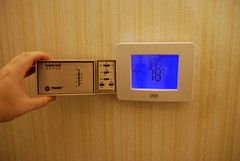
(ARA) - With the onset of cooler weather, people are starting to think about green - specifically, paying for heating bills and holiday expenses. A sure way to save green, as in money, is by making your home more energy efficient and space heating the rooms where you spend the most time instead of heating the entire house.
Over the past 10 years, a growing number of homeowners are choosing to heat those areas with renewable fuels, such as wood pellets, in
pellet stoves or fireplace inserts. In addition to saving money, they are saving green, as in the environment, since burning pellets is considered carbon neutral. Pellets are grown, harvested and produced right here in the U.S., so they are also doing their part to reduce our country's dependence on foreign oil.
A simple approach to weatherproofing
Improving your home's ability to retain heat will save you money. Weatherproofing can be broken down into a few simple steps, starting with adding insulation to your attic if needed and replacing worn-out weather stripping around doors and windows. These are do-it-yourself projects within the capabilities of many homeowners.
Having your home's heating system serviced and the ductwork cleaned are also important steps. You'll likely need to hire professionals for these tasks, but the improved efficiency of the entire system will make the minor investment well worth the cost.
Finally, install a programmable thermostat for your central heat system. Setting the temperature lower during the day when you are gone, and at night when you're safely tucked under the comforter, can result in significantly lower heating bills. The average homeowner can save about $180 a year by properly setting a programmable thermostat, according to EnergyStar.gov.
Consider space heating with alternative fuels
Fossil fuels, such as propane and fuel oil, release harmful greenhouse gases into the environment. While it may be impractical to completely replace fossil fuels in your home, it is possible to heat areas with renewable fuels like wood pellets. This involves having a pellet stove installed in a central area, or a
pellet insert installed into the firebox of an existing wood-burning fireplace. To gain efficiencies, try turning the temperature down 10 to 15 degrees on your central furnace and use the pellet appliance to heat the areas where you spend the most time. Similar to the concept of a hybrid car, the pellet appliance provides the primary heat with the furnace as a backup - working together for a more environmentally responsible outcome.
"Today's pellet stove technology is light-years ahead of what it was even 10 years ago, making heating with renewable pellet fuel a practical option for many households," says Jeni Forman, vice president of marketing for Quadra-Fire and Harman, makers of pellet-fueled stoves. "Many models can produce steady, regulated heat for up to 24 hours on a single load of pellets, with minimal ash clean up. Due to pellet density and high burn efficiencies, the stoves emit extremely low outside-air particulates, helping to reduce air pollution and greenhouse gases associated with fossil fuels."
Now is an opportune time to purchase a
pellet stove or fireplace insert. Buy one before Dec. 31, 2010, and a federal tax credit can reimburse you for 30 percent of the cost, up to $1,500. You can realize more savings if your home's central heat system uses fuel oil, propane or electricity. Based on 2010 fuel prices and fully heating a 1,700 square foot home in cold-climate areas such as Upper New England, the Midwest and Northwest, switching from fuel oil to pellets can save approximately $800 per heating season. If you are currently heating with propane, the savings would be about $1,000, and if currently using electricity, $1,800 per heating season.
"The combination of weatherproofing your home and space heating with a pellet appliance has many benefits," says Forman. "From tax credits on pellet stoves, to real savings on utility bills, these green home improvements can really add up for homeowners this winter."
Visit fireplaces.com to learn more.


































